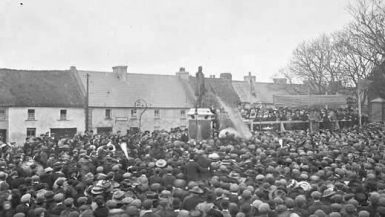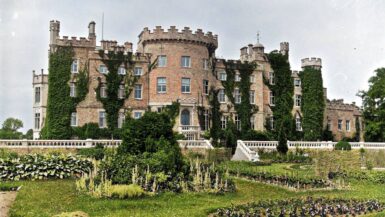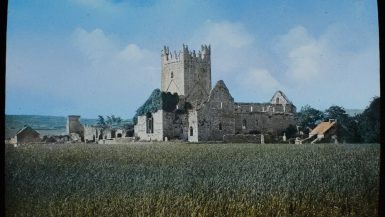ACHONRY, a parish, in the union of Swinford, barony of Leney, county of Sligo, and province of
Connaught, 6 miles (W. S. W.) from Ballymote; containing 17,986 inhabitants. This place, anciently called
Achad, Acliad-Conair, and Achad-Chauin, was granted about 530, by the chief of the territory of Luigny, to
St. Finian, Bishop of Clonard, who founded an abbey here, and placed over it his disciple St. Nathy, afterwards Bishop of Achonry. There are few events of historical importance : in 1798, the French invaders
marched from Castlebar through Tubbercurry, near Achonry, where a slight skirmish took place. The
parish is situated on the river Moy, and on the roads from Boyle to Ballina and from Sligo to Swinford ;
it comprises 60,896 statute acres, of which about 24,000 are arable and pasture land, and the remainder
mountain and bog, much of which the peasantry are reclaiming. The land is generally good, and the system
of husbandry is improving : there are quarries of excellent limestone and granite. Petty-sessions arc held at
Tubbercurry every Thursday. There are also weekly markets at that place and Bellaghy , and several fairs
are held there and at Bellaghy and Curry, which see.
The diocese is one of the sixteen constituting the ecclesiastical province of Armagh. It comprehends a
large portion of the county of Sligo and part of that of Mayo, and extends about 35 miles in length and 27
in breadth, comprising by estimation a superficial area of 207,650 plantation acres, of which 113,950 are in
Sligo, and 93,700 in Mayo. From about the commencement of the 17th century it was held with the see of Killala, as one bishopric, till 1833, when they were both annexed, under the provisions of the Church
Temporalities’ Act (3rd of William IV.), to the see of Tuam. The chapter consists of a dean, precentor,
archdeacon, and the three prebendaries of Ballysodare, Killaraght, and Kilmovee ; there are neither minor
canons nor vicars choral. The cathedral, dedicated to St. Nathy, and called the cathedral church of St.
Crumnathy, Achonry, is parochial : it is kept in good repair by the Ecclesiastical Commissioners ; there is
no economy fund. The diocese comprehends 25 parishes, of which three are consolidated rectories and
vicarages, two appropriate rectories, and the remainder vicarages of which the rectories arc impropriate : the number of benefices is nine, all of which, with the dignities and prebends, arc in the patronage of the Bishop of Tuam, except the deanery, which is in the gift of the Crown; there is one perpetual cure dependent on the deanery. The see lands comprise 11,784 acres, of which 8391 are profitable land and the glebe lands of the benefices consist of 187 1/4 Irish acres. The gross annual revenue of the diocese, payable to the Ecclesiastical Commissioners, is on au average £1481. 6. 9.; and the entire rent-charges in the diocese, in lien of tithes, amount to £5516 per annum, of which about £3412 are payable to the clergy, and the remainder to lay impropriators. In the Roman Catholic divisions the diocese includes also the parishes of Kilgarvan and Attymass (which in the Established church form part of the adjoining diocese of Killala) ; and, as originally founded, continues a distinct bishopric, suffragan to that of Tuam, and comprising 19 parochial unions or parishes.
The living is a rectory and vicarage, in the diocese of Achonry, with the rectory and vicarage of Cloonoghill and the rectories of Killoran and Kilvarnet united, together constituting the corps of the deanery
of Achonry. The tithe rent-charge is £485 ; and the gross revenue of the deanery, or union, is £720 per annum, out of which the dean allows a stipend of £75 to the perpetual curate of Tubbercurry. The church is a plain edifice with a tower and spire, and was built in 1823 by a loan of £1476 from the late Board of First
Fruits. The deanery, or glebe-house, was built in 1816 by a gift of £100 and a loan of £1500 from the same
Board , the glebe comprises 34 acres. In the Roman Catholic divisions this parish forms the benefice of the
dean, and is divided into three portions, called the Upper, Middle, and Lower Divisions : the first is Curry,
in which there are two chapels, one at that place and the other at Moylough ; the second is Cloonacool, in
which also are two chapels, one there and the other at Tubbercurry ; and the third is Mnllinabriny, which
has one chapel. The ruins of the old church are situated near the present edifice : there are also ruins
of the abbey of Court, founded by O’Hara for Franciscan friars of the third order ; of an old church
and burial-place at Kilcummen , and of an ancient fortified residence at Castlelough. There is a large cromlech at Achonry, and at Ballincurry is a mineral spring.
Extract from: Lewis – A Topographical Dictionary of Ireland





Leave a reply